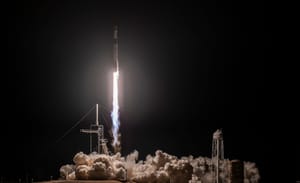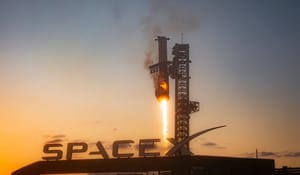
Jul 29, 2024
Falcon 9 returns!
Falcon 9 returned to flight on July 27th at 05:45 am, Universal Coordinated Time, from Launch Complex 39A, in Florida. The launch vehicle had been grounded for approximately fifteen days after a second-stage failure.
This return-to-flight mission carried twenty-three Starlink satellites atop of the vehicle. SpaceX's decision to carry its own Starlink satellites removes the risk of potentially losing a customer payload, while closely replicating flight conditions present during the failure.
Falcon 9 lifts off from pad 39A in Florida! pic.twitter.com/ozYLYUxCss
— SpaceX (@SpaceX) July 27, 2024
Liftoff of Falcon 9 for its return to flight mission, via SpaceX on X
The booster supporting this mission was B1069 making its seventeenth flight. B1069 successfully landed on the drone ship 'Just Read The Instructions' in the Atlantic Ocean after separating from the second-stage. Previous missions for B1069 include Eutelsat HOTBIRD 13F, OneWeb 1, CRS-24, SES-18 and SES-19, and twelve Starlink missions.
Falcon 9 lands on the Just Read the Instructions droneship pic.twitter.com/56KSGFLeON
— SpaceX (@SpaceX) July 27, 2024
Landing of B1069 on the drone ship 'Just Read The Instructions', via SpaceX on X
What caused the failure?
SpaceX currently believes that the failure of the previous mission resulted from a crack on a pressure sensor line. This crack is believed to be the source of the noticeable propellant leak.
The crack in the pressure sensor line was part of the second-stage liquid oxygen system and was damaged due to fatigue from vibrations along with 'looseness' in a clamp that would have secured the line.

This would ultimately culminate in a 'hard start' of the second-stage engine, leading to a supposed loss of the engine and attitude control. After this, SpaceX claims that the second-stage completed the process to safe itself, via venting of stored energy, along with deploying the Starlink satellites that were onboard.
To mitigate this issue, SpaceX has removed the pressure sensor line that caused the failure. This pressure sensor line is claimed to have no impact on the flight termination system, with other sensors capable of monitoring the safe use of the second-stage engine. The change was also tested at the company's McGregor test facility prior to the return-to-flight mission.
Still on track?
SpaceX is still believed to be aiming to complete 148 launches of Falcon 9 in 2024, 2023 saw Falcon 9 launch 96 times. Currently Falcon 9 and Falcon Heavy have performed 73 launches this year.
Since the return to flight mission on the 27th, two more Falcon 9 launches have occurred. Both missions carried a batch of Starlink satellites into low Earth orbit.
For SpaceX to reach 148 Falcon-series launches, a Falcon 9 and Falcon Heavy would have to launch every two days. Current estimates place Falcon 9 and Falcon Heavy completing around 130 launches for 2024.
The 2024 goal for @SpaceX is 148 launches (Falcon).
— SpaceX 2024 Progress (@SpaceX_Deimos) July 28, 2024
This is 52 launches more than 2023.
SpaceX is currently on track for 128 launches this year.
2024 stats:
🚀 72x F9
🚀 1x FH
🚀 2x Starship
🐉 3x Dragon ( 2x 🧑🚀, 1x 📦) pic.twitter.com/c7X36NKCxX
SpaceX's launch progress for 2024, via SpaceX_Deimos on X



